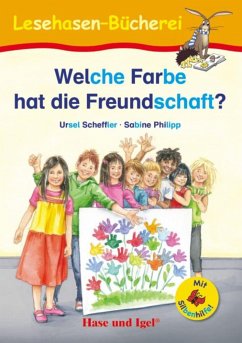Welche Farbe hat die Freundschaft? by Ursel Scheffler und Jan Lieffering (2005, republished in 2018)
2005 Edition:

Republished in 2018 with a reader’s
guide:

Max ist the
main protagonist in this Kindergarten story. Through his eyes and his interaction
with the other kids and especially the ‘foreign ones’, we encounter difference
and how it is dealt with at this early age. Two kids especially stand out –
Mira from Turkey and Joschua from Africa (it’s obviously not important to state
his country; the Continent is enough to place him!). They are physically much
darker than the other kids. Mira initially stood out because of her inability
to speak German, while for Joschua, it was his skin colour. Mira is now well
integrated in the kindergarten, in fact her German is a little better than
Max’s, jokes the narrator. Later, the reader gets an insider look at Mira’s
home when Max visits her one afternoon. Here, we are offered a crash course on
Islam – we learn about the mosque, fasting (Ramadan) and Eid, about the Quran,
praying etc. When Max is picked up by his father, he notes that each person is
quite different from the other. In other words, the protagonist Max is now
comfortable with Mira’s difference which doesn’t seem so strange or
intimidating any more, whereas his own difference is left untouched. The Other
is seen through the lens of the white ‘German’ child while the one doing the ‘Othering’
remains hegemonic.
There is a
seemingly interesting exercise inserted in the book with the following message –
we are all different and that is what makes us special: People in different
countries are different and even here at home, we are all different. However, the
message seems to get lost in the overarching paternalism and silencing of the Black voiceless character - only
Joshua’s hands stick out at first, but then the kids realise that their
fingerprints and the shapes of their hands are all different.
What is
quite disturbing is the seemingly harmless but denigrating approach to children
of a different skin colour – Joshua is asked if he can’t remove the dirt from
his skin. Darkness is seen at once as frightening, very different and very
foreign. Joschua seems to be part of the group but we hear nothing further
about him and he isn’t given a voice – we just know he stands out in the Kasper
puppet theatre game because of his darkness. Differences are not presented
on an equal footing and this somehow reinforces biases.
‘What
colour is friendship?` is meant to
introduce children to diversity and different ‘skin colours’.
What is
problematic about its approach? Difference focuses solely on being Black, Muslim
or Turkish. These categories are othered and therefore, different from the
German ‘WE’. The humanistic argument is – you are different and come from some
other place, but we still accept you DESPITE how you may speak or look. The persistent
association with difference and skin colour is detrimental to a society, both
for its White and non-White kids.
PS. The interesting reading project 'Book Towers'/büchertürme.de is the brainchild of the writer of this picture book, Ursel Scheffler.
No comments:
Post a Comment